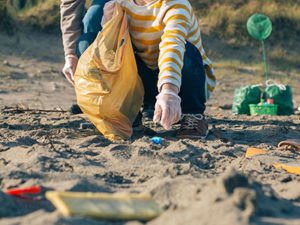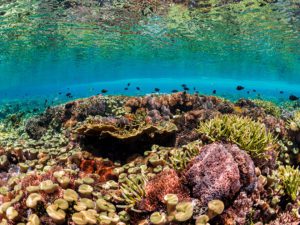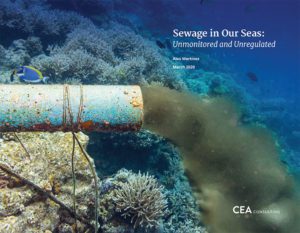Data Highlights
Plastics entering the ocean
9–14 million MT per year
Pew and SYSTEMIQ, 2020
Global access to managed sanitation
4.2 billion people (4 in 10 people)
WHO, 2019
Untreated sewage into the ocean
80% of global wastewater
UN, 2017
Jump to:
Overview
The ocean has historically been treated as a dumping ground for society’s wastes, under the guise that “dilution is the solution to pollution.” While some of this pollution is highly visible (e.g., oil and large plastics), other types are less conspicuous but similarly insidious (e.g., toxins and microplastics). Pollution in marine and coastal environments can take many forms: from physical and chemical-based pollution to nonphysical forms, such as thermal, noise, and biological pollution.
The aggregate effect of all pollution on the marine environment is not fully known due to the diffuse nature of sources and incomplete data, but indicators suggest that it is likely worsening. Nutrient pollution can have acute impacts—for example, in the form of large-scale nutrient runoff associated with eutrophication (i.e., an excess of nutrients) and subsequent hypoxia (i.e., oxygen deficiency) events. Other pollutants such as bioaccumulating toxins present a more pervasive threat both to the marine food web and to human health given that they have long half-lives and accumulate at higher trophic levels. Plastic debris, primarily from land-based sources, represents an emerging and escalating threat given that plastics are being produced at historic levels that are projected to increase. Based on current trends, the global quantity of plastic in the ocean could nearly double to 250 million metric tons by 2025—or one ton of plastic for every three tons of fish.1
Sources and impacts of pollution
There are four major sources that discharge pollution into the ocean that are both land-based and in the marine environment: municipal, agricultural (excluding aquaculture), industrial and maritime:2
Land-based sources of pollution include:
- Municipal sources include residential and commercial solid waste and wastewater, runoff from roads and landscaping activities, and marine debris from natural disasters.
- Land-based agricultural activities can lead to inputs of nutrients (nitrogen and phosphorus primarily), animal waste, pesticides, and plastic.
- Industrial inputs from land-based manufacturing can result in pollutants such as plastic pellets and plastic waste, other solid waste, industrial chemicals (including persistent organic pollutants), heavy metals, pharmaceuticals, pharmaceutical waste products, and oil and gas.
Marine-based sources of pollution (considered in more depth in the Industrial Impacts chapter) include:
- Maritime pollution stems from shipping, cruise, oil and gas, ocean-based aquaculture and fishing industries, and several other maritime industries (including recreational boating) – communications (deep sea cables), mining (minerals, sand), and energy (oil and gas, renewables). Pollution includes litter, food waste, sewage, dredge spoils, industrial chemicals and anti-foulants, heavy metals, oil and gas, and accidental debris (such as “ghost gear”).
- Ocean-based aquaculture: fish waste, antibiotics, parasiticides, antifoulants containing heavy metals, and lost equipment.
Sources of Ocean Pollution

Source: Graphic developed by K. Youngblood. Published in: Jambeck, J., E. Moss, B. Dubey et al. 2020. Leveraging Multi-Target Strategies to Address Plastic Pollution in the Context of an Already Stressed Ocean. Washington DC: World Resources Institute. Available online at: https://oceanpanel.org/blue-papers/pollution-and-regenerative-economy-municipal-industrialagricultural-and-maritime-waste.
Sewage pollution, which is a mounting but often overlooked threat to both ocean and societal health, makes up the largest percentage of coastal pollution worldwide.3 Roughly 80 percent of the world’s wastewater is discharged—untreated or only partially treated—into lakes, rivers, streams, and the ocean.4 The impacts of sewage pollution include degradation to critical habitats and ecosystems, mortality for marine life, harm to human health, and damage to coastal identities and livelihoods.
Pollution remains a global problem across countries of all income and governance levels. Over 480 nutrient pollution hotspots have been identified globally, with notable persistent challenges in the North Sea, Gulf of Mexico, eastern United States, and East Asia.5 The large-scale input of nutrients (i.e., nitrogen, phosphorus) can result in eutrophication and declining oxygen levels. As a proxy for eutrophication, the number of marine “dead zones” or hypoxic sites has continued to increase in number and severity in recent decades. Since 1950, global fertilizer use has increased 10-fold to meet food demands for a growing population.6 As a result of this fertilizer use, nitrogen discharges from rivers to coastal waters increased an estimated 43 percent from 1970 to 2000, with more than three times as much nitrogen contributed from agriculture as from sewage.7 In the United States and Europe, agricultural sources are the primary sources of nutrient pollution in waterways. In South America, Asia, and Africa, urban wastewater is often a leading source of nutrient pollution.
Global Nitrogen Use and Hypoxic Areas in the Ocean

Note: Mismanaged use on land and incidences of eutrophication and hypoxia. Source: Data compiled from Potter et al. 2011a; World Resources Institute 2013. Map created by A. Brooks. Published in: Jambeck, J., E. Moss, B. Dubey et al. 2020. Leveraging Multi-Target Strategies to Address Plastic Pollution in the Context of an Already Stressed Ocean. Washington DC: World Resources Institute. Available online at: https://oceanpanel.org/blue-papers/pollution-and-regenerative-economy-municipal-industrialagricultural-and-maritime-waste.
Deoxygenation is one of the most consequential anthropogenic impacts on the ocean, given that oxygen decline can cause major changes in ocean productivity, biodiversity, and biogeochemical cycles.8 Global models are in consensus that the combined effects of climate change and eutrophication will lead to continued decline in oxygen levels in the ocean, likely by a few percent by 2100.9 However, there is uncertainty about the spatial distribution of future hypoxic sites.10 Declining oxygen and the resulting impact on fisheries productivity are likely to affect local economies and food security, particularly small-scale fishers with low adaptive capacity.
Low and Declining Oxygen Levels in the Ocean and Coastal Waters
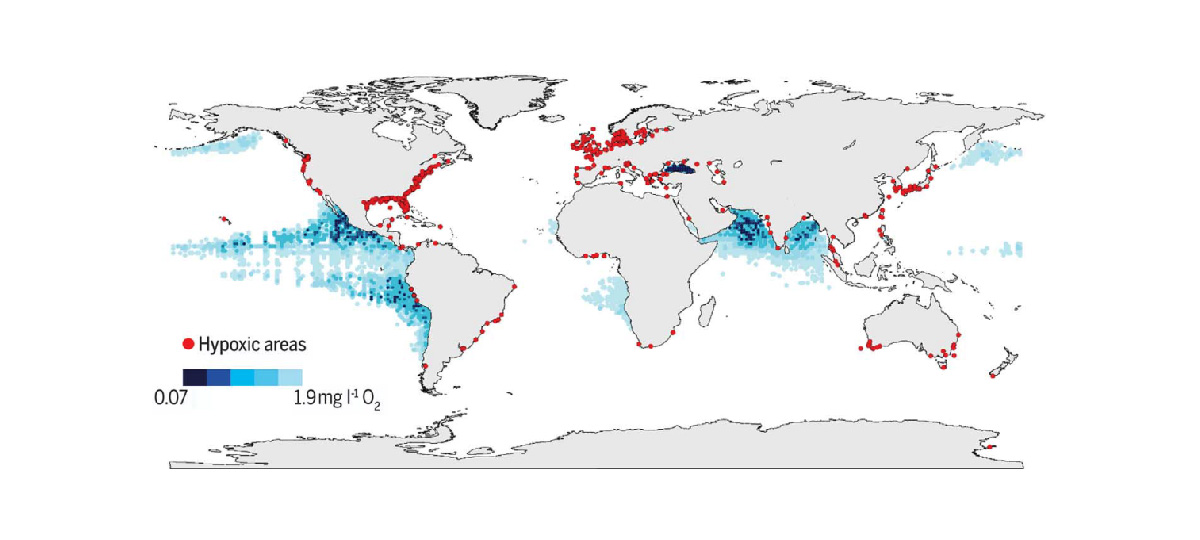
The global map indicates coastal sites where anthropogenic nutrients have exacerbated or caused O2 declines to <2 mg liter−1 (red dots), as well as ocean oxygen-minimum zones at 300 m of depth (blue shaded regions). Source: Breitburg, Denise, L.A. Levin, A. Oschlies, M. Grégoire, F.P. Chavez, D.J. Conley, V. Garçon, et al. “Declining Oxygen in the Global Ocean and Coastal Waters.” Science 359, no. 6371 (2018): https://doi.org/10.1126/science.aam7240.
Plastic debris accounts for the largest portion of marine pollution in the ocean by volume. Roughly half of all plastic ever produced was made in the last 15 years.11 Global plastic production has increased nearly 200-fold, from 2 million tonnes in 1950 to 381 million tonnes in 2015. During 1950–2015, plastic production grew at a compound annual growth rate of 8.4 percent, roughly 2.5 times the rate of global GDP.12 Asia is the leading producer of plastic: nearly 50 percent of global production was in Asia in 2015, of which China accounted for almost 30 percent of production.13
Global plastics production (1950–2015)
The absolute amount of plastic entering the ocean is difficult to estimate given the wide range of sources and transport pathways. However, plastics are now ubiquitous in the marine environment, found everywhere from the once-pristine Arctic Ocean to remote, uninhabited South Pacific atolls.14 Research indicates that plastic debris is even found in the deepest parts of the ocean, thousands of kilometers from shore, which is concerning given that deep-sea ecosystems have high endemism and very slow growth rates. Microplastics are an emerging issue of concern: though there is consensus that microplastics are highly persistent in the environment, there are significant gaps in our understanding of how microplastics affect animal and human health.15
The best available estimates suggest annual plastic flows to the ocean are in the range of 9 million to 14 million metric tons per year. Under a business-as-usual scenario, the annual flow of plastic into the ocean is projected to nearly triple by 2040 to roughly 29 million metric tons per year.16,17 The extent and quality of waste management remains a key determinant in terms of which countries contribute the most significant plastic waste inputs per capita from land into the ocean. Over half of plastic entering the ocean comes from five rapidly growing economies—China, Indonesia, the Philippines, Thailand, and Vietnam.18 Interventions in these five countries could reduce global plastic-waste leakage by roughly 45 percent over the next ten years.19
Spatial Patterns of Plastic Production and Pollution
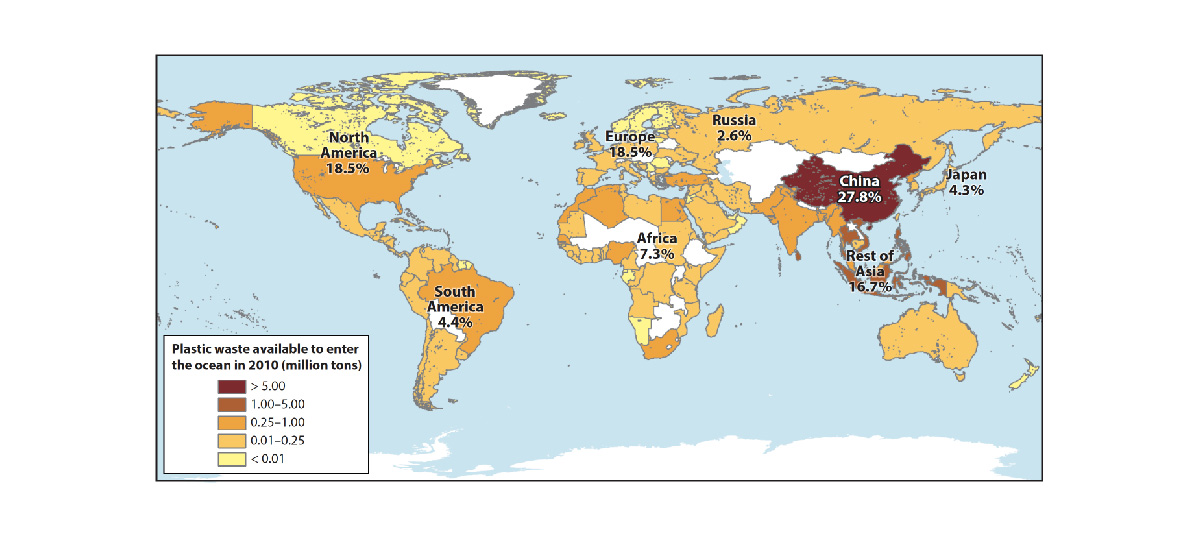
This map shows the percentage contributions of different regions to global plastic production. The estimated mass of mismanaged plastic waste in million tons (MT) is shown by the color gradient, based on 2010 generation estimates by populations living within 50 km of the coast. Figure redrawn from Jambeck et al, 2015. Source: Worm, Boris, H.K. Lotze, I. Jubinville, C. Wilcox, and J. Jambeck.“Plastic as a Persistent Marine Pollutant.” Annual Review of Environment and Resources 42, no. 1 (2017): 1-26. https://doi.org/10.1146/annurev-environ-102016-060700.
Entanglement and ingestion of plastic is one of the most documented impacts of plastic pollution on marine life. Notable increases in plastic ingestion have been documented in seabirds and marine turtles alike, with an annual rate of increase of 1.7 percent for seabirds and 0.7 percent for turtles in recent years.20 Researchers expect that both lethal and sublethal impacts from plastic ingestion will result in population-level changes among these marine species.21 While quantitative data remain limited at the global level, an expert survey suggests that among types of plastic pollution, marine mammals are most vulnerable to experience negative impacts from lost or intentionally discarded fishing gear (“ghost gear”), followed by plastic bags.22 Given the increasing accumulation of both fishing gear and plastic bags in the ocean, it is likely that marine mammals have also experienced increasing rates of plastic entanglement and ingestion in recent years.
Increasing Effects of Plastic Pollution on Sea Bird and Sea Turtle Species
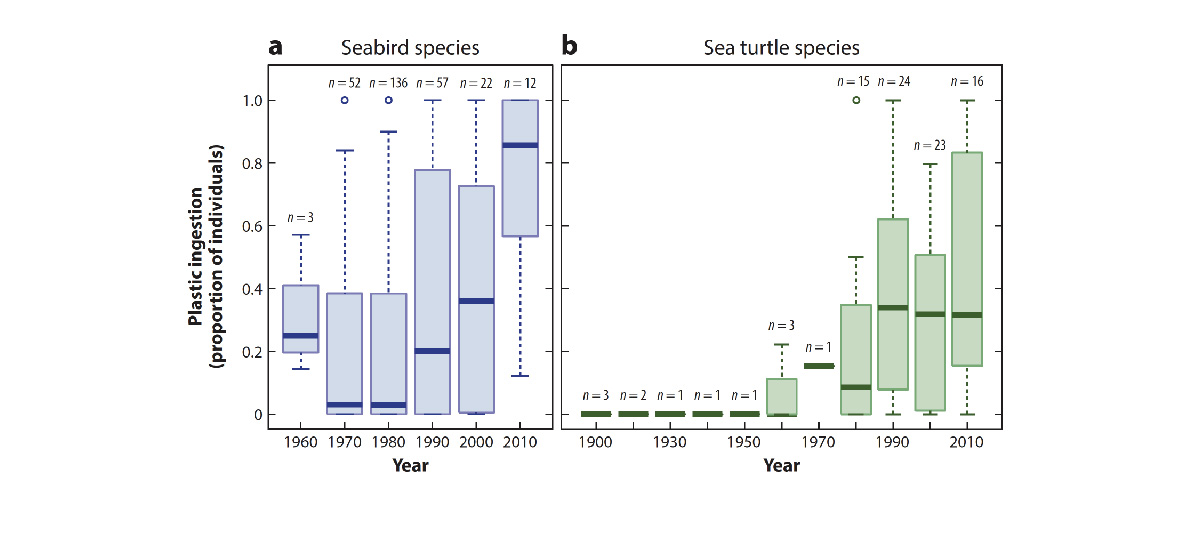
Shown are results from two comprehensive studies on time trends in plastic ingestion for (a) seabirds and (b) sea turtles. Data represent the median proportion of individuals in a taxon with plastic in their digestive system. The median is calculated over all studies in a given decade. (Upper and lower estimates are quartiles, with bars extending to 1.5 times the interquartile range, n = number of unique species by study combinations). Source: Worm, Boris, H.K. Lotze, I. Jubinville, C. Wilcox, and J. Jambeck.“Plastic as a Persistent Marine Pollutant.” Annual Review of Environment and Resources 42, no. 1 (2017): 1-26. https://doi.org/10.1146/annurev-environ-102016-060700
Barriers to progress
Across all sources, there are several barriers to progress which have impeded the advancement of solutions. These barriers include:
- Significant data gaps around key global indicators, such as the location and extent of hypoxic zones and eutrophication, and the amount of plastic entering the ocean
- Economic constraints of implementing solutions over the long-term, given the low cost of ubiquitous global plastic production in the short-term (which does not consider negative externalities)
- Technical and economic challenges in promoting precision fertilizer application and reducing non-point source pollution
- Limited awareness of the scale of pollution (beyond plastic pollution) and the associated impacts of human health and marine wildlife and ecosystems
There are known interventions for addressing the threat of ocean pollution. Key solution sets for achieving the reduction of pollutants in the ocean include: improving wastewater and stormwater management, implementing coastal zone improvements, adopting closed loop and other radical efficiency resource practices, shifting individual behavior, and increasing regulatory standards. For additional detail on the solutions landscape and to explore individual interventions, see the Pollution Solutions chapter.
Notes
- Worm, Boris, H.K. Lotze, I. Jubinville, C. Wilcox, and J. Jambeck. “Plastic as a Persistent Marine Pollutant.” Annual Review of Environment and Resources 42, no. 1 (2017): 1-26. https://doi.org/10.1146/annurev-environ-102016-060700.
- Jambeck, J., E. Moss, B. Dubey et al. 2020. Leveraging Multi-Target Strategies to Address Plastic Pollution in the Context of an Already Stressed Ocean. Washington DC: World Resources Institute. Available online at: https://oceanpanel.org/blue-papers/pollution-and-regenerative-economy-municipal-industrialagricultural-and-maritime-waste.
- Wear, Stephanie L., and Rebecca Vega Thurber. “Sewage Pollution: Mitigation Is Key for Coral Reef Stewardship.” Annals of the New York Academy of Sciences 1355, no. 1 (2015): 15–30. https://doi.org/10.1111/nyas.12785.
- “The United Nations World Water Development Report 2017. Wastewater the Untapped Resource.” United Nations World Water Assessment Programme, 2017. http://www.unesco.org/new/en/natural-sciences/environment/water/wwap/wwdr/.
- World Resources Institute. Interactive Map of Eutrophication and Hypoxia. Available here: https://www.wri.org/our-work/project/eutrophication-and-hypoxia/interactive-map-eutrophication-hypoxia
- Breitburg, Denise, L.A. Levin, A. Oschlies, M. Grégoire, F.P. Chavez, D.J. Conley, V. Garçon, et al. “Declining Oxygen in the Global Ocean and Coastal Waters.” Science 359, no. 6371 (2018): https://doi.org/10.1126/science.aam7240.
- Ibid.
- Barboza, Luís Gabriel Antão, A. Dick Vethaak, Beatriz R.B.O. Lavorante, Anne-Katrine Lundebye, and Lúcia Guilhermino. “Marine Microplastic Debris: An Emerging Issue for Food Security, Food Safety and Human Health.” Marine Pollution Bulletin 133 (2018): 336–48. https://doi.org/10.1016/j.marpolbul.2018.05.047.
- Breitburg, Denise, L.A. Levin, A. Oschlies, M. Grégoire, F.P. Chavez, D.J. Conley, V. Garçon, et al. “Declining Oxygen in the Global Ocean and Coastal Waters.” Science 359, no. 6371 (2018): https://doi.org/10.1126/science.aam7240.
- Ibid.
- Geyer, Roland, J.R. Jambeck, and K.L. Law. “Production, Use, and Fate of All Plastics Ever Made.” Science Advances 3, no. 7 (2017). https://doi.org/10.1126/sciadv.1700782.
- Ibid.
- Worm, Boris, H.K. Lotze, I. Jubinville, C. Wilcox, and J. Jambeck. “Plastic as a Persistent Marine Pollutant.”
- Chiba, S. “Human footprint in the abyss: 30-year records of deep-sea plastic debris.” Marine Policy 96 (2018): 204-212. https://doi.org/10.1016/j.marpol.2018.03.022.
- Barboza, Luís Gabriel Antão, A. Dick Vethaak, Beatriz R.B.O. Lavorante, Anne-Katrine Lundebye, and Lúcia Guilhermino. “Marine Microplastic Debris: An Emerging Issue for Food Security, Food Safety and Human Health.” Marine Pollution Bulletin 133 (2018): 336–48. https://doi.org/10.1016/j.marpolbul.2018.05.047.
- Pew and SystemIQ. “Breaking the Plastic Wave: A Comprehensive Assessment of Pathways Towards Stopping Ocean Plastic Pollution.” https://www.pewtrusts.org/-/media/assets/2020/07/breakingtheplasticwave_report.pdf.
- Jambeck, J., R. Geyer, C. Wilcox, T.R. Siegler, et al., “Plastic Waste Inputs from Land into the Ocean,” Science 347 (2015): 768-71.
- McKinsey & Company and Ocean Conservancy. “Stemming the Tide: Land-based strategies for a plastic-free ocean.” September 2015. https://oceanconservancy.org/wp-content/uploads/2017/04/full-report-stemming-the.pdf.
- Ibid.
- Worm, Boris, H.K. Lotze, I. Jubinville, C. Wilcox, and J. Jambeck. “Plastic as a Persistent Marine Pollutant.”
- Ibid.
- Wilcox, C. et al. “Using expert elicitation to estimate the impacts of plastic pollution on marine wildlife.” Marine Policy 65 (2016): 107-114. https://doi.org/10.1016/j.marpol.2015.10.014

